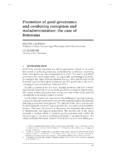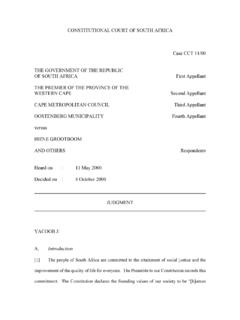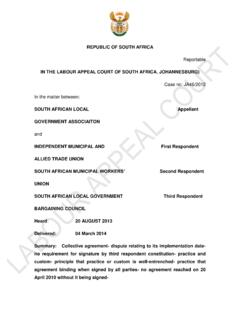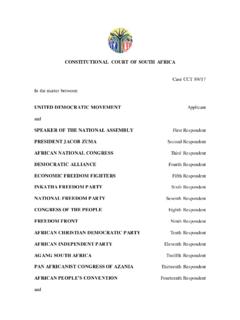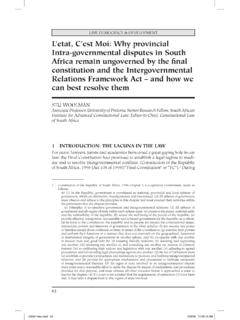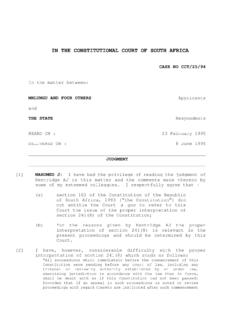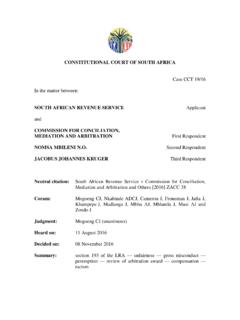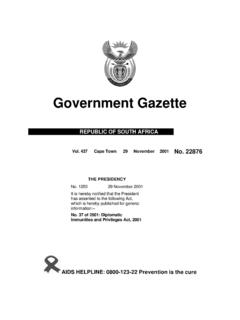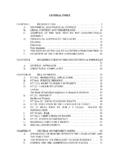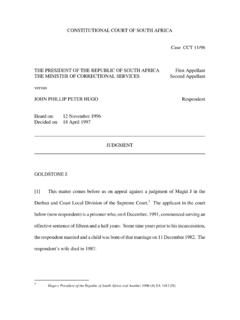Transcription of CONSTITUTIONAL COURT OF SOUTH AFRICA Case CCT …
1 CONSTITUTIONAL COURT OF SOUTH AFRICA . Case CCT 10/2000. JOHAN GEORG DORMEHL Applicant versus THE MINISTER OF justice first respondent THE registrar OF companies Second respondent CHAIRMAN OF THE justice SUB COMMITTEE Third respondent MR justice J P ROUX Fourth respondent THE justice AND PEACE CATHOLIC CHURCH, PRETORIA Fifth respondent Decided on : 14 April 2000. JUDGMENT. CHASKALSON P : [1] The applicant has applied in terms of Rule 17 for direct access to this The proceedings, initiated by the applicant in person, are not in conformity with the requirements of 1. Rule 17(1) provides: An application for direct access as contemplated in section 167(6)(a) of the Constitution shall be brought on notice of motion which shall be supported by an affidavit which shall set forth the facts upon which the application relies for relief.. CHASKALSON P. the rules of this The application was launched by a document entitled Application for Direct Access supported by an affidavit deposed to by the applicant.
2 The Application for Direct Access is not in the form of a notice of motion as the rules require. It consists of a mixture of arguments, averments of fact, and statements of the relief sought which are not always clear or coherent. The applicant does not appear to have had the benefit of legal advice and in the particular circumstances of this case I consider it appropriate to ignore the formal defects in the notice launching the application and deal with it on its merits. [2] It is possible to discern from the application the relief that the applicant wishes to claim. It is as follows: first , that this COURT order that the following rules and practices are inconsistent with the Constitution and are accordingly invalid: a) Rule 17 of the rules of the CONSTITUTIONAL COURT requiring the applicant to obtain the leave of this COURT in order to approach it directly. b) That corporations have to be represented in legal proceedings in superior courts by a legal practitioner who has a right of audience before such COURT , and cannot 2.
3 Rule 10(2) requires applications to be brought on notice of motion which .. shall be as near as may be in accordance with Form 1 or 2, as the case may be. Forms 1 and 2 appear in Schedule 1. of the Rules. 2. CHASKALSON P. be represented by a lay person. c) Any provision requiring a litigant to furnish security for costs. d) Any provision requiring an unsuccessful litigant to obtain leave to appeal in order to prosecute an appeal to a higher COURT . In particular, the applicant has challenged the constitutionality of such a requirement in rule 18 of the rules of this Secondly, the applicant seeks a mandamus against the fourth respondent , a judge of the High COURT , requiring him to submit a proper written judgment of his findings on the 2nd of April 1998 in a matter in which an oral judgment was given by the judge on that date. [3] The applicant has cited as respondents the Minister of justice , the registrar of companies , the Chairman of the justice Sub-Committee (it appears from the papers that the person intended to be cited is the Chairman of the National Assembly's Portfolio Committee on justice and CONSTITUTIONAL Affairs), the Judge referred to in paragraph 3 above, and the justice 3.
4 Rule 18 concerns appeals to this COURT from courts other than the Supreme COURT of Appeal. Rule 18(7). requires a party wishing to appeal to this COURT from such a COURT to lodge an application for leave to appeal with the registrar . 3. CHASKALSON P. and Peace Catholic Church Pretoria . The applicant does not indicate what direct interest each of the respondents has in the various orders sought by him. Nor does he indicate what direct interest he has in the relief that he claims. In the view that I take of this matter, however, nothing turns on these procedural defects. The applicant has not made out a case for direct access, and the matter can be dealt with in terms of rule 17(5) which entitles this COURT to deal with the application .. summarily, without hearing oral or written argument other than that contained in the application itself.. The constitutionality of rule 17. [4] It is convenient to deal first with the contention that Rule 17 is unconstitutional.
5 It is contended that the requirement of the rule that direct access is permissible only with leave of the COURT infringes the right of everyone under section 34 of the Constitution to have .. any dispute that can be resolved by the application of law decided in a fair public hearing before a COURT .. There is no merit in this contention. The procedure requiring such leave is specifically sanctioned by the Constitution4. In any event section 34 does not confer on litigants a right to approach any COURT in the COURT hierarchy for relief. As long as there is a right to approach a COURT of competent jurisdiction for the relief claimed, the requirements of the 4. Section 167(6) of the Constitution provides: National legislation or the rules of the CONSTITUTIONAL COURT must allow a person, when it is in the interests of justice and with the leave of the CONSTITUTIONAL COURT . (a) to bring a matter directly to the CONSTITUTIONAL COURT ; or 4. CHASKALSON P. section are met.
6 The high courts have jurisdiction in CONSTITUTIONAL matters5 and litigants are entitled to bring claims concerning such matters before those courts. Rule 17. regulates the circumstances in which litigants may bypass the high courts, which are ordinarily the courts of first instance in such matters and approach the CONSTITUTIONAL COURT directly for relief. [5] There are good reasons for rule 17. They have been explained in previous judgments of this COURT dealing with applications for direct Briefly, they are as follows: (b) to appeal directly to the CONSTITUTIONAL COURT from any other COURT .. 5. This jurisdiction, however, is subject to the provisions of section 167(4) which are not relevant to the present matter. 6. See Bruce and Another v Fleecytex Johannesburg CC and Others 1998 (2) SA 1143 (CC); 1998. (4) BCLR 415 (CC) at paras 4 - 9 and Christian Education SOUTH AFRICA v Minister of Education 1999 (2) SA 83 (CC);1998 (12) BCLR 1449 (CC) at para 8. 5. CHASKALSON P.
7 A) The CONSTITUTIONAL COURT is the highest COURT in all CONSTITUTIONAL matters. It acts as a COURT of appeal and in limited circumstances as a COURT of first instance. b) It is not ordinarily in the interests of justice for a COURT to sit as a COURT of first and last instance, without there being any possibility of an appeal against its decisions. Nor is it in the interests of justice for eleven judges of the highest COURT in CONSTITUTIONAL matters to hear matters at first instance which can conveniently be dealt with by a single judge of a high COURT . c) The Constitution recognises this and for that reason provides that direct access to the CONSTITUTIONAL COURT is permissible only with leave of the COURT and if the interests of justice so require. d) One of the factors to be taken into account in dealing with such matters is the prospects of success. But this is not the only consideration. Since a high COURT has jurisdiction in CONSTITUTIONAL matters and is the COURT which ought ordinarily to be approached to deal with CONSTITUTIONAL matters at first instance, compelling reasons are required to justify a different procedure.
8 An applicant for direct access must establish that there are such reasons, and that the circumstances of the case justify a departure from the ordinary rule, and the granting of direct access. 6. CHASKALSON P. Can a corporation appear before a COURT in person ? [6] The applicant objects to the provisions of rule 7(1). This rule provides: Except where the COURT or the President directs otherwise, no person shall be entitled to appear on behalf of any party at any proceedings of the COURT unless he or she is entitled to appear in the high courts.. The effect of this rule is that persons having a right of audience in high courts will also have a right of audience in the CONSTITUTIONAL COURT . [7] The applicant's objection to rule 7(1) apparently arises out of a judgment given in 1964. in the matter of Dormehl's Garage (Pty) Ltd v Magagula7 in which it was held that a company may not be represented in a high COURT unless represented by an advocate. The applicant asks that this decision be declared unconstitutional.
9 The decision was given long before the Constitution came into force. No question can arise now as to its validity then. If a corporation in which the applicant has an interest is presently engaged in litigation, and if the corporation wishes to challenge the correctness of the decision in the Dormehl's Garage case that issue can be raised in such proceedings. The opposing litigant will then have an opportunity of dealing with that contention. Such an issue cannot ordinarily be brought before this COURT as an abstract 7. 1964 (1) SA 203 (T). See also Yates Investments (Pty) Ltd v CIR 1956 (1) SA 612 (A). 7. CHASKALSON P. question of law divorced from any concrete Security for costs 8. See, for example, President, Ordinary COURT Martial, and Others v Freedom of Expression Institute and Others 1999 (4) SA 682 (CC); 1999 (11) BCLR 1219 (CC); S v Dlamini, S v Dladla and Others, S v Schietekat 1999 (4) SA 623 (CC); 1999 (7) BCLR 771 (CC). 8. CHASKALSON P. [8] The applicant makes a general averment that any provision requiring a litigant to furnish security for costs is unconstitutional.
10 There are provisions in various statutes and rules of COURT dealing with the furnishing of security for costs, some of which have been the subject of CONSTITUTIONAL The applicant does not say which particular provision he challenges, but as he has cited the registrar of companies as the second respondent in these proceedings, he presumably intends the challenge to include at least the requirements of section 13 of the companies Act 61 of 1973. The constitutionality of this provision was dealt with by a high COURT in Lappeman Diamond Cutting Works (Pty) Ltd v MIB Group (Pty) Ltd (No 1)10 where the COURT held that the section is not inconsistent with the Constitution. If the applicant is associated with a company which is engaged in litigation and is affected by the requirements of section 13, or any other provision requiring security for costs to be furnished, the question of the constitutionality of such provisions must be raised in that litigation so that the opposing litigants have an opportunity of dealing with it.
